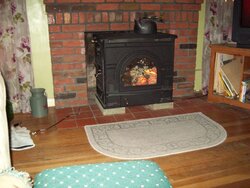nonetheless said:
Are there in thermophysicists in the house.
Is there such a thing? I'm not but I did take heat transfer in college... Let me take a stab at it that hopefully doesnt drone on like a lecture....
All our stoves heat by all 3 means - conduction, convection and radiation. The difference that a blower provides is forced convection that lets you pull more heat energy from the stove in a given time period than would be possible naturally.
You can visualize with an experiment...
Take 2 identical stoves (A and B), with an identical load of wood and identical stage of burning, placed in identical rooms at identical room temp and identical chimney... ehh you get the idea.
Example #1
- Assume that neither stove has any type of thermostatic air control (no bimetal coil)
- Set both stoves air control for exactly 500F on the stovetop.
- Turn on the blower for stove B and let both stoves burn out.
The result:
The BTU/hr rate of heat transfer to the room for stove B will increase. The room temp will initially be higher than A, but the stovetop temp will be lower.
In theory the length of burn and the ending temperature of the rooms at the end of the burn cycle would be the same however, since you keep the amount of fuel and air inlet to the stove constant. But in reality the cooler stove would probably make the fire burn less efficient (smouldering send more unburnt fuel up the chimney as smoke) so you might actually get less overall heat out of the fire over the entire burn cycle.
The cooler, smokier fire could also result in more creosote buildup.
------------------------------------------------------
Example #2
-
Assume that the stoves have a thermostatic air control that will maintain the stovetop temp at the set temperature
- Set both stoves air control for exactly 500F on the stovetop.
- Turn on the blower for stove B.
The result:
The BTU/hr rate of heat transfer to the room for stove B will increase. The room temp will be higher than A. The temperature of stove A will start to go down, but the thermostat will compensate by opening up the air control. More air makes the fuel burn down faster but keeps the stove at 500.
The result will be that if you don't reload, stove A will burn out before stove B. Thus after both have burned out the temperature of both rooms should eventually even out.
If you do reload, stove B can keep the room hotter longer, but burns more fuel doing so.
-----------------------------------
The bottom line is that a blower can increase the rate at which a stove turns fuel into heat, however the amount of heat that a given mass of wood produces is fixed in either case.
-Jeremy


